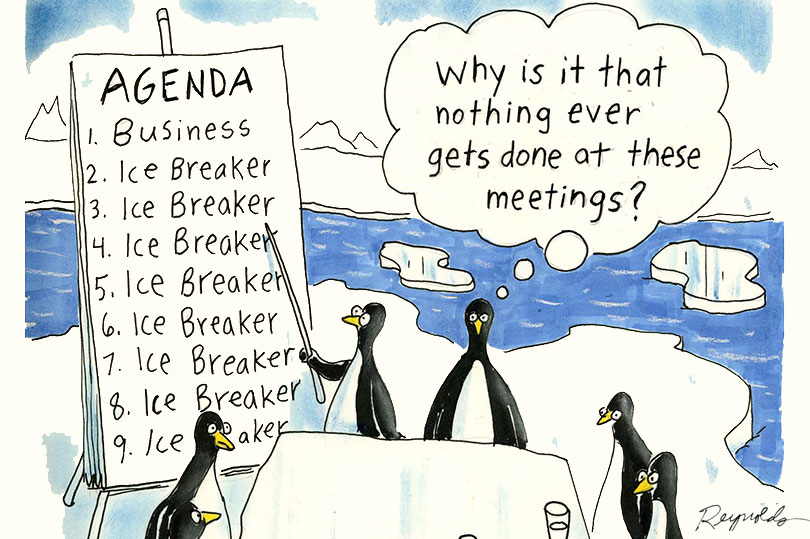Icebreaker
An icebreaker is an activity you can use at the beginning of a meeting to make attendees more comfortable with each other, encouraging them to speak up, listen up, join in, and open up to new ideas.
What Is an Icebreaker?
An icebreaker is an activity or game designed to "break the ice" between attendees in a meeting. In general, it is used at the beginning of the session to introduce participants to each other, get them relaxed and energized for the upcoming activities.
Icebreakers are unrestricted to the beginning of a meeting, neither to a random group of attendees. You can use one at the start, during, and at the end of the session. Icebreakers also help with setting a safe space for attendees (even for familiar ones) to learn and share.
Why You Might Want Use Icebreakers?
 Source: Icebreakers example
Source: Icebreakers example
Icebreakers are fun and remarkable ways to start meetings or training sessions. They are a versatile and adaptable tool used to make the attendees more comfortable with each other, encouraging them to speak up, listen up, join in, and open up to new ideas.
These activities foster networking and a sense of community due to the experience exchange. They can set the tone for the upcoming session and give participants ownership of the learning, with no pressure or high expectations.
Problems Icebreakers Help to Solve
- Higher anxiety and stress levels pre-meeting
- Low interaction with unknown colleagues
- Low engagement to speak up
- Demotivated team
- Decrease in energy levels during non meaningful meetings
- Toxic Team Culture
How to Implement Icebreakers?
One of the best places to find an icebreaker is online. However, you should be careful since they are often tagged with abstract attributes (e.g.: fun, simple, fail-safe), which might be misleading. When looking for an icebreaker, you must have in mind the goal you want to achieve, the time to be spent, and if it will help or not to achieve the goal.
Bellow, are some examples of how to choose icebreakers aiming for a specific goal.
-
If your goal is to introduce participants (or enhance their interactions), the chosen activity should focus on the individual presentations and establishing a bonding way between attendees.
-
If the aim is to introduce the meeting topic, you may want a fun activity, or even something more casual and thoughtful. For example, something related to questions and answers that prepare people for the following experiences.
-
If the main goal is to help a group to form a team, probably icebreakers that enforce teamwork, trust, and communication will be the best approach.
As already said, there is plenty of online sites teaching the most diverse activities, but if you are looking for a quick start, I would like to recommend the following ones as guidance for your journey on the icebreakers world.
Another perfect place to find out this type of activity is your imagination. With it, you can create brand new ones, repurpose old ones, combine them, adapt and enhance existing ones, improve them to be used remotely, and so on. If you would like inspiration or some guidance on how to create a brand new icebreaker, you can check here.
Common Pitfalls of Icebreakers
- Some of them you can not use online
- They can easily be misused, making people feel uncomfortable or displease
- Introverts may not engage
Resources for Icebreakers
More information:
More icebreakers examples:
Want to write for DXKB?
Feel free to contribute. People from DXKB community will be more than happy.
Related articles
ALL ARTICLES
Agile Events
Agile Events are necessary meetings for keeping up the good work. They are usually time-boxed and the most common Agile framework that uses these periodic rituals is Scrum.
Read moreMentoring
Mentoring is a supportive learning relationship between a mentor who shares knowledge, experience, and wisdom and mentee who is ready and willing to benefit from this exchange, to enrich their professional journey.
Read moreHome Office
Home office or remote working means working from a person's residence for official business purposes. The term also means the Ministry of Interior in the UK or the domiciled headquarters of a large company.
Read moreProduct Owner
A Product Owner represents the voice of stakeholders. The Product Owner decides what needs to be delivered by the developers to satisfy the stakeholders and to maximize the value of the product.
Read moreDesign Sprint
A Design Sprint is a framework that reduces the risks associated with product development. It is an intense process done by a small team in just 3 - 5 days.
Read moreALL ARTICLES